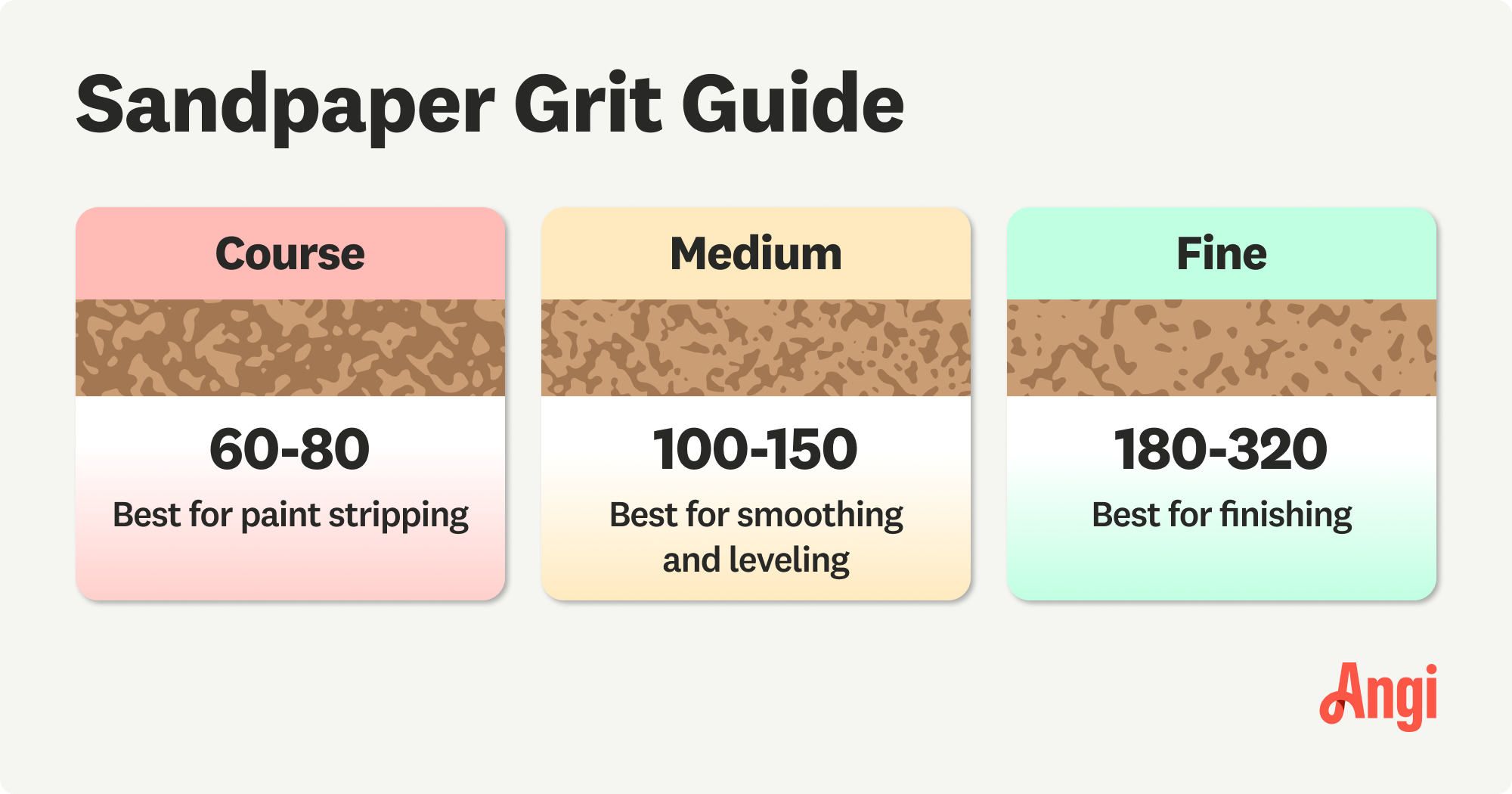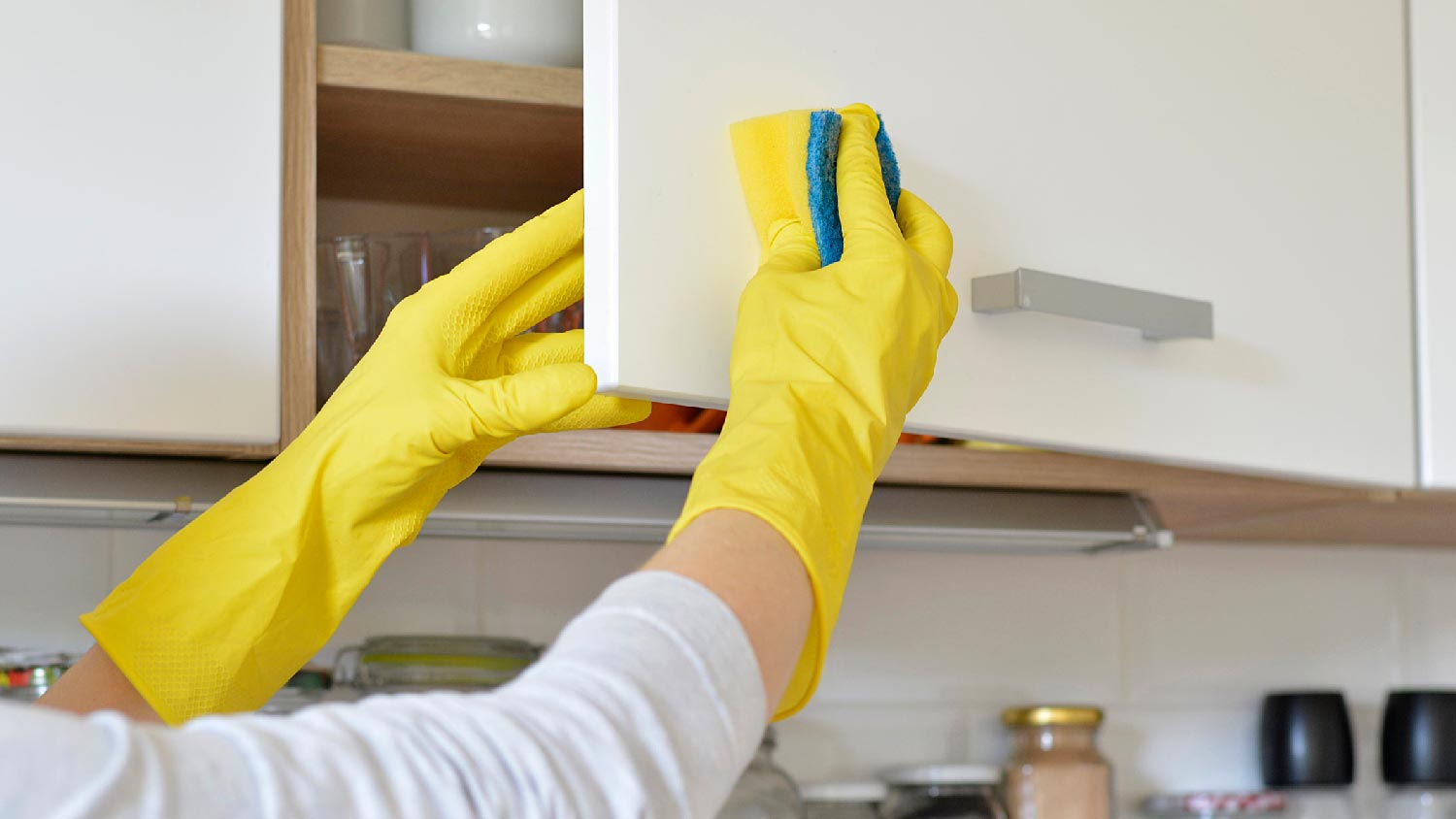How to Sand Cabinets for Flawless Painting
Your cabinet glow-up starts with a bit of grit


We’ll be honest: Sanding cabinets is not a thrilling part of a kitchen refresh. But if you skip the process, your fresh coat of paint or stain will not adhere properly, spotlighting any surface flaws. For homeowners who want a pro-level finish, it all starts with grit. Here’s how to sand cabinets for painting.
Why Do You Need to Sand Cabinets?

While sanding is labor-intensive, it sets the stage for a successful project with professional results. The process strips off old paint or wood stain and any grimy buildup that cleaning alone won't remove. The resulting surface allows fresh primer, paint, or stain to adhere correctly, creating an even and long-lasting finish.
Sanding is also mandatory on unpainted wood if you notice the wood grain is raised and uneven. If sanding is not possible, there are ways to restore kitchen cabinets without sanding, but it is not highly recommended.
How Much Does It Cost to Finish Cabinets?
DIYers can sand their cabinets after investing between $100 and $500 in tools and materials like an electric sander, sanding pads, and protective gear, including goggles, gloves, and a respirator or dust mask. If DIY is not your thing, you can hire a local cabinet painter.
The cost of professional cabinet painting can range from $425 to $1,460, depending on your home’s location and the number of cabinets in your kitchen. The significant upside is that pros have all the gear to do a stellar job and will handle ventilation issues related to sanding.
How to Sand Your Kitchen Cabinets

There are several ways to sand your cabinets. Each method uses different tools and techniques and offers various benefits, but they all begin with prep work.
Prep Your Cabinets and Work Area
Remove all cabinet doors, drawers, including their hardware, like hinges, handles, and knobs. It is a good idea to place small pieces like these in baggies and then label them or snap a few photos with your phone for later reference.
Next, clean the surfaces you plan to sand. Grab a degreaser made for cabinets, or use a mix of warm water and dish soap, then wipe down with clean towels or rags. Experts suggest allowing the cabinets to dry in a well-ventilated area for 24 to 48 hours.
Finally, place drop cloths or plastic sheeting on all exposed surfaces to catch dust. This will make cleanup after sanding much more manageable.
DIYers must wear goggles, gloves, and a mask or respirator to shield themselves from harmful dust particles and fumes.
Hand Sanding
Hand sanding is the most accessible and budget-friendly method, especially if you have a small kitchen with few cabinets. You will not need power tools—just elbow grease, patience, and a few supplies. One of the most significant advantages of hand sanding is that it can get into tight spots that an electric sander could easily damage.
You have a few choices regarding what to sand with. You can purchase a manual hand sander, which you attach to different pieces of sandpaper. They typically come with a handle that makes gripping the sander much easier.
DIYers can also consider sanding sponges, which resemble thick rectangular dish sponges covered with a gritty finish. They are great for wet and dry sanding and delicate or hard-to-reach areas. We suggest using a manual hand sander on flat surfaces and a sanding sponge on decorative or hard-to-reach spots for the best results.
Here's how to determine what sandpaper grit to use on your cabinets:
Start with coarse-grit sandpaper to remove the old paint or stain.
Follow up with medium grit to smooth the surface and make it less gritty.
Continue with a finer grit to refine the surface.
Finish with extra fine grit to create a pristine and polished finish.
Remember, while hand sanding is labor intensive, it does offer unmatched control, meaning you are less likely to sand excessively or, just as bad, accidentally gouge the wood.
Orbital Sander

If you are a homeowner with flat-front cabinetry, consider an orbital sander. This electric tool is excellent for quickly removing old finishes. Unlike similar items like a belt sander, it is less aggressive and much easier to control. It moves in small circular patterns, significantly reducing visible sanding marks or uneven spots on the surface.
As with hand sanding, start with a coarse grit to remove the existing paint or stain finish. Afterward, you will switch to a medium grit and progress to a fine and extra fine grit before painting or staining.
Be mindful of edges or corners. Orbital sanders can chew through delicate wood or veneer quickly if you apply too much pressure or let it linger in one spot. Always keep the sander moving in a steady, overlapping pattern to prevent gouging or creating uneven, low spots.
Detail Sander
Thanks to their small, compact size, detail sanders are easy to maneuver and have a pointed tip perfect for sanding contoured areas, corners, or grooves.
These electric tools often come with a kit of interchangeable sanding pads in various grits, allowing you to move quickly from coarse to extra fine. This handy tool is much faster than hand sanding and works nicely on intricate cabinetry.
Sanding Attachments
These small attachments, which you use with a drill or oscillating tool, are suitable for sanding decorative finishes and detailed edging on cabinets.
You will find them in all grits in barrel, cone, and disc shapes. However, these tiny attachments are not ideal for large surfaces. Additionally, inexperienced DIYers can risk damaging decorative flourishes, so it is best to practice before sanding anything of value in your home or leave delicate areas to a pro.
Chemical Paint Stripper
In some instances, you need a chemical paint stripper to remove any sticky residue and smooth the wood grain before sanding, such as when lifting off a heavy finish, such as multiple layers of old paint, stubborn varnish, or shellac.
Apply the stripper evenly with a brush or sponge according to the manufacturer's instructions. When the finish starts to bubble or soften, grab a plastic scraper to remove the layers without damaging the wood underneath. Once most or all of the finish is gone, sand the surface to prep it for paint or stain.
Only use chemical strippers in well-ventilated areas, or even better, outside, while wearing protective gear.
Tips for Effective and Safe Cabinet Sanding

These tips can make or break your cabinet refinishing project. Here's how to avoid common pitfalls so any DIYer can achieve great results.
Protect your space and health: Work in a well-ventilated area, use drop cloths or plastic sheets to catch debris, and seal off doorways so the mess doesn't spread to other rooms.
Don’t skip prep work: Remove hardware, doors, and drawers, and clean the cabinets thoroughly before sanding.
Use the right grit: You’ll need a variety of sandpaper grits for the different stages of this project. Start with coarse grit to strip existing paint and finish with extra fine. Sand with the grain, not against it.
Sand carefully: Don’t press too hard on cabinet surfaces, or you risk creating an uneven surface that paint or stain will only highlight later. Lighten your touch, especially around corners, edges, and decorative areas.
DIY vs. Hiring a Pro
Many ambitious DIYers might think sanding cabinets is a straightforward project. But if you are new to sanding, it is more demanding and labor-intensive than expected. Achieving a smooth, even surface requires great technique regardless of the tools used. One minor slip-up can easily lead to visible imperfections, which may require cabinet replacement.
Hiring a local cabinet painter ensures the job is done quickly, cleanly, safely, and flawlessly. Experts have experience working with different cabinet types and understand how to sand decorative details. Paying for expert craftsmanship is more cost-effective in the long run than fixing a DIY misstep.
Frequently Asked Questions
If you don't sand your cabinets, the new paint or stain won’t adhere properly, impacting the final finish and leading to peeling, chipping, or a sloppy result that won't stand the test of time. Sanding removes the old finish, smooths imperfections, and gives the new coat something to grip. Without it, you will waste your time, money, and effort.
You should not clean cabinets with vinegar. While many homeowners think it is a natural cleaner, vinegar is a mild acid, not a degreaser. Since it does not cut through greasy grime, it won't effectively remove it from kitchen cabinets. For best results, use a degreasing cleaner designed for prep work, then rinse and dry thoroughly before sanding.





- The Pros and Cons of Painting Kitchen Cabinets
- Should I Paint or Refinish My Kitchen Cabinets?
- Who Do I Hire to Paint Kitchen Cabinets?
- How to Paint Kitchen Cabinets: A Complete Guide
- How To Build Cabinets: 9 Steps to Follow
- Should You Paint Your Cabinets White? Here Are the Pros and Cons.
- What to Do When Your Painted Cabinets Feel Rough
- 10 Updates to Make Your Kitchen Cabinets Look New Again
- How to Clean Kitchen Cabinets With Ease
- The A-to-Z Guide to Unfinished Cabinets











